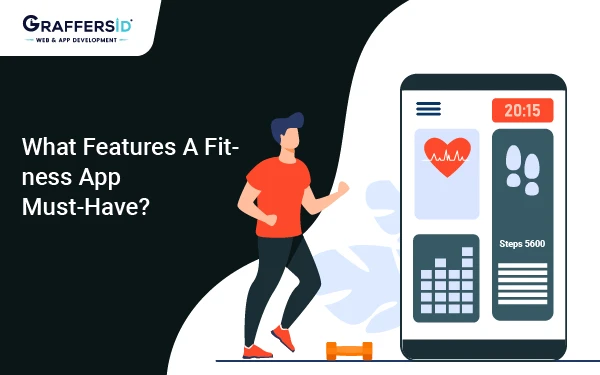The global spread of the coronavirus has taken a major hit on the fashion industry and tumbled many stocks, however, one sector that is sustaining growth during the crisis is virtual health and wellness. Faced with quarantine and lockdowns, people are tapping telehealth and e-fitness platforms, causing their stocks to surge. There are several fitness apps available on the app store with millions of downloads. The owners have understood and worked on the crucial fitness app features before entering into the development phase.
Amidst the uncertainty about when things will be back to normal, many fitness professionals are transitioning to a virtual workout program through free workout suggestions on social media and apps.
If you are also the one who is planning to take your fitness services online, then this is the perfect time to hit the market. Let’s not directly jump to hire healthcare software developers, first understand the types of fitness apps and all the functionalities that your business app must have.
Different Types of Fitness Apps
There are innumerable fitness apps in app stores, but all of them are not popular. If you want to create a fitness application, first learn about the application that customers love the most:
High-Intensity Interval Training:
HIIT is a type of applications that offer customers a short period of training that include lots of highly intensive exercises. Such exercises require plenty of energy and burn plenty of calories in a short time. However, this isn’t safe with the audience who has just started doing a workout, so, keep this in mind while building your fitness application. Some of the finest examples of HIIT applications are Interval Timer and Seconds Pro.
Activity Tracking App:
Activity tracking apps are the ones that cover one specific kind of activity or a lot of them. These types of applications cover a person’s movements, as well as the distance, traveled, calories burned, number of steps climbed, and other such metrics.
While building an activity-tracking app, it is important to keep in mind that these apps work better if they are compatible with wearable devices. Gadgets like Fitbit and smartwatch significantly extend the functionality of fitness applications.
Activity tracking applications generally integrate social share features. For example, Google FIT and Nike Training Club allow customers to share their progress with friends on the social network. Adding such a feature to your fitness application will make you provide training to the users along with their friends and other fitness enthusiasts.
Personal trainer or studio app:
Personal trainer apps are created for the personal needs of a trainer or studio and their clients. Such programs can have different types of functionalities. Some Studio application works like an organizer, through which user organizes or cancels their training. They also have a newsfeed, where a trainer posts some updates.
When you are creating your fitness application, it is important to keep in mind that Live streaming is also one of the most crucial fitness app features. A user arranges a session with a trainer and conducts a training session anywhere. Using the live streaming feature, the trainer can explain to the user if he is doing the exercise correctly or not.
Diet and Nutrition App:
Diet and Nutrition App apps help users keep track of the consumed calories. A user chooses a product he ate from the list, enters its weight and a precise number of calories pops on the screen. This helps people to keep a count of the number of calories they are having during the day. Some of these applications also have a barcode scanner which enables them to purchase healthy products.
All these applications comprise features such as Calorie Counter, which you can find in the My Fitness Pal app. It is one of the most downloaded diet and nutrition apps available on the Google Play store.
If you are also looking to develop a fitness application like Fitness App, the professional developers at Graffersid can help.
Meditation App:
The yoga and meditation apps usually constitute a range of sessions that are classified according to the level of a user. A person can choose the level or program he or she wants to get. Such an app generally consists of daily sessions, which means these apps have a high retention rate. Many of the meditation and yoga app has a reminder option to inform a user at a specific time.
Some of the best examples of Yoga applications are Alo Moves and Down Dog.
To satisfy the needs of modern-day customers, the majority of popular fitness applications are trying to combine several features into one. For instance, HIIT and activity tracker applications these days can also have a calorie calculator or yoga app that can have a daily step counter.
here are Mobile App Development Ideas for Startups to Thrive Amid COVID
Here are the Basic Features a Fitness App Must Have
Log-in
Having a feature to create a personal account is basic and a must-have. Various applications either suggest logging in through applications like Google+, Twitter, Instagram, and Facebook or signing up via email. It is better to provide your users with both options.
Social Integration
Through Social Integration, the information stored on a social network will be synchronized with the fitness app. In addition to this, authorizing an application via Facebook makes the search for friends easier; hence it is better to combine some functions of a social network with your application. Many apps allow users to publish the results on Facebook along with screenshots of targets they have achieved during the workout.
Personal Account
Several types of data should be added manually by the user according to their body type and the rest can be configured in settings. Suggest users add a profile picture by either taking a new photo or downloading it from a library. Don’t forget to make users choose between kilograms and pounds when it comes to weight and between feet and meters when it comes to height. Try to be international.
Device Connectivity
With the emerging trend of fit bands, it is good to have a mobile application that is compatible with as many trackers as possible. Fortunately, fitness band producers and mobile platforms, offer fitness app developers such a chance.
User activity tracking
Traditional fitness applications are generally focused on activities like running, cycling, walking, and more. The application shows several steps made, miles run, time taken and calories burned. It is better to integrate both, tracking with the help of Fitbit and using smartphone sensors.
Geolocation
With this feature of the fitness app users can track their current position, build walking routes, track their current position, and record workouts. To learn more about how this feature works in the Fitness app, go through the recorded routes on Strava.
Target Setting
It is one of the must-have features that every activity-tracking application should have. Let users plan and set achievable. They should constantly move forward towards their goal.
Workouts
Workouts may differ depending on the type of application. Most of the tracking apps come with a feature to allow you to create a custom workout plan or choose from the offered ones.
Notifications
Workouts and exercises are all about regularity. A few missed workout sessions and you will lose all your shape. That’s why reminders are a crucial feature of fitness or yoga apps. Although they should not be annoying. Time and frequency are the main variables. In case the user is ill or busy, he should be capable of adjusting them.
While working on the idea of a fitness application, don’t forget that the key to the success of healthcare app development is user engagement. And, visualization plays an important role in this process. Hence, you need to provide the user with detailed reports and analytics.
Must Read: How to Create a Fitness App that Thrives in the Market
Progress Tracking and Analytics:
The ability to track progress is a powerful motivator for users. Fitness apps should include robust tracking features that allow individuals to monitor their achievements, set goals, and receive insights into their performance. Graphs and charts displaying data such as calories burned, workout duration, and improvements over time provide users with a tangible representation of their hard work.
Integration with Wearable Devices:
Incorporating compatibility with wearable devices such as fitness trackers and smartwatches adds a new dimension to the user experience. Seamless integration allows users to sync data effortlessly, providing real-time feedback and enhancing the accuracy of activity tracking. This feature not only boosts convenience but also elevates the overall effectiveness of the fitness app.
Comprehensive Exercise Library:
Variety is the spice of life, and the same holds for fitness routines. A diverse exercise library with clear instructions and video demonstrations is essential for keeping users engaged. Whether it’s strength training, cardio, or flexibility exercises, a comprehensive library ensures that users can create varied and effective workouts.
Real-time Feedback and Coaching:
Incorporating real-time feedback during workouts can significantly improve user performance. Features like instant form correction, audio cues, and motivational messages provide users with guidance and encouragement, simulating the experience of having a personal trainer by their side.
Goal Setting and Achievement Badges:
Goal-setting is a fundamental aspect of fitness motivation. A fitness app should allow users to set specific, measurable, achievable, relevant, and time-bound (SMART) goals. Rewarding achievements with badges, virtual trophies, or other gamification elements adds an extra layer of motivation, turning the fitness journey into a rewarding and enjoyable experience.
Offline Mode:
Recognizing that users may not always have access to a stable internet connection, an offline mode is crucial. This feature allows users to download workouts, instructional videos, and other content for offline use, ensuring that individuals can stick to their fitness routines regardless of connectivity challenges.
In-App Challenges and Competitions:
To foster a competitive spirit and keep users engaged, fitness apps can include challenges and competitions. Whether it’s a step challenge, a 30-day fitness challenge, or a virtual race, these events create a sense of excitement and friendly competition among users.
Integration with Music Platforms:
Music is a powerful motivator during workouts. Integrating with popular music streaming platforms or providing built-in playlists can enhance the overall exercise experience. Users should have the ability to customize their workout playlists based on their preferences and workout intensity.
Sleep and Recovery Tracking:
Recognizing the importance of recovery in a fitness regimen, integrating features for sleep tracking and recovery recommendations adds value. Understanding how sleep patterns impact performance allows users to optimize their rest and recovery, contributing to overall well-being.
Virtual Coaching and Workouts:
For those who prefer guided workouts, incorporating virtual coaching features can be a game-changer. This could include live or pre-recorded workout sessions led by certified trainers, offering users the option to follow along with expert guidance.
Integration with Health Platforms:
Seamlessly connecting with broader health platforms, such as Apple Health or Google Fit, ensures that users can consolidate their health data in one place. This includes syncing information on physical activity, nutrition, and other health metrics for a comprehensive overview of their well-being.
Customizable Notifications:
Providing users with the ability to customize notifications ensures that they stay informed without feeling overwhelmed. Whether it’s a reminder to complete a workout, celebrate an achievement, or receive feedback, customizable notifications cater to individual preferences.
Augmented Reality (AR) Workouts:
Leveraging AR technology, fitness apps can offer immersive and interactive workout experiences. AR workouts can guide users through exercises in real-world settings, adding an innovative and engaging dimension to their fitness routines.
Conclusion:
In conclusion, the evolution of technology has undeniably transformed the way we approach fitness and well-being. The myriad of fitness apps available today provide us with powerful tools to enhance our health journey. As we explored the essential features a fitness app must have, it became evident that a holistic approach, incorporating personalization, user engagement, and data analytics, is crucial for a truly effective fitness application.
From tracking workouts to monitoring nutrition, and fostering a supportive community, the ideal fitness app seamlessly integrates into users’ lives, inspiring and empowering them to reach their wellness goals. As technology continues to advance, we can expect even more innovative features to emerge, catering to the diverse needs and preferences of users.
Build Your Fitness App with GraffersID’s Remote Developers!
Now that you understand the key features a fitness app must possess, it’s time to turn your vision into reality. At GraffersID, we bring you a dedicated team of experienced remote developers who specialize in creating cutting-edge fitness applications. Our talented professionals are committed to delivering top-notch solutions that align with your unique requirements.
Why settle for mediocrity when you can have a customized fitness app that stands out in the crowded market? Take the next step towards success by partnering with GraffersID. Let our remote developers turn your fitness app idea into a reality, ensuring it not only meets but exceeds the expectations of your target audience.
Visit our website today to learn more about how GraffersID can be your trusted partner in building a groundbreaking fitness app. Your journey towards a healthier and more technologically advanced future starts here!




